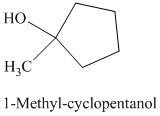
Interpretation:
The product of the reaction of cyclopentanone with the given reagents is to be predicted.
Concept Introduction:
Lithium aluminum hydride and sodium borohydride are strong reducing agents. They are inorganic compounds which are used as the reducing agents in
In the reaction of
By catalytic hydrogenation, aldehydes are reduced to primary alcohols. Grignard reagents react with ketones and aldehydes to form alcohols. These reactions are nucleophilic addition reactions. The Grignard reagent adds to the carbonyl group of aldehydes and ketones due to electronegativity difference between carbon and oxygen.
An organolithium reagent acts like a good nucleophiles and strong bases. They used for the conversion of aldehydes and ketones into primary and secondary alcohols. Acetal is an organic compound with general formula
Answer to Problem 28P
Solution:
a) The product of the reaction of cyclopentanone with lithium aluminum hydride, followed by water is shown below.

b) The product of the reaction of cyclopentanone with sodium borohydride, methanol is shown below.

c) The product of the reaction of cyclopentanone with hydrogen (nickel catalyst) is shown below.

d) The product of the reaction of cyclopentanone with methylmagnesium iodide, followed by dilute acid is shown below.

e) The product of the reaction of cyclopentanone with sodium acetylide, followed by dilute acid is shown below.

f) The product of the reaction of cyclopentanone with phenyllithium, followed by dilute acid is shown below.

g) The product of the reaction of cyclopentanone with methanol containing dissolved hydrogen chloride is shown below.

h) The product of the reaction of cyclopentanone with ethylene glycol, p-toluenesulfonic acid, benzene is shown below.

i) The product of the reaction of cyclopentanone with aniline

j) The product of the reaction of cyclopentanone with dimethylamine, p-toluenesulfonic acid, benzene is shown below.

k) The product of the reaction of cyclopentanone with hydroxylamine is shown below.

l) The product of the reaction of cyclopentanone with hydrazine is shown below.

m) The product of the reaction of cyclopentanone with product of part (l) heated in triethylene glycol with sodium hydroxide is shown below.

n) The product of the reaction of cyclopentanone with p-Nitrophenylhydrazine is shown below.

o) The product of the reaction of cyclopentanone with semicarbazide is shown below.

p) The product of the reaction of cyclopentanone with ethylidenetriphenylphosphorane is shown below.

q) The product of the reaction of cyclopentanone with sodium cyanide with addition of sulfuric acid is shown below.

r) The product of the reaction of cyclopentanone with chromic acid is shown below.

Explanation of Solution
a) The product obtained by the reaction between cyclopentanone and lithium aluminum hydride followed by water.
The reaction of cyclopentanone with lithium aluminum hydride, followed by water gives alcohol as the final product. Lithium aluminum hydride reduces cyclopentanone to cyclopentanol. The product of this reaction is shown below.

b) The product obtained by the reaction between, cyclopentanone and the reagent, sodium borohydride, methanol.
The reaction ofcyclopentanone with sodium borohydride, followed by methanol gives alcohol as the final product. The product of this reaction is shown below.

c) The product obtained by the reaction between cyclopentanone and the reagent, hydrogen (nickel catalyst).
The reaction of cyclopentanone with hydrogen in the presence of nickel catalyst gives cyclopentanol as the final product. The product of this reaction is shown below.

d) The product obtained by the reaction between the given compound, cyclopentanone and the reagent, methylmagnesium iodide, followed by dilute acid.
The reaction of cyclopentanone with methylmagnesium iodide that is Grignard reagent, followed by dilute acid gives alcohol as the final product. The product of this reaction is shown below.

e) The product obtained by the reaction between the given compound, cyclopentanone and the reagent, sodium acetylide, followed by dilute acid.
The reaction ofcyclopentanone with sodium acetylide, followed by dilute acid gives alcohol. The product of this reaction is shown below.

f) The product obtained by the reaction between, cyclopentanone and the reagent, phenyllithium, followed by dilute acid.
The reaction of cyclopentanone with phenyllithium, followed by dilute acid gives alcohol as the final product. The product of this reaction is shown below.

g) The product obtained by the reaction between the given compound, cyclopentanone and the reagent, methanol containing dissolved hydrogen chloride.
The reaction of aldehydes and ketones with two equivalents of an alcohol results in the formation of acetals. The product of this reaction is shown below.

h) The product obtained by the reaction between the given compound, cyclopentanone and the reagent, Ethylene glycol, p-toluenesulfonic acid, benzene.
In the reaction of ketone with ethylene glycol, p-toluenesulfonic acid and benzene, the protection of the carbonyl group of ketone takes place. For carbonyl protection, ethylene glycol is the commonly used group. The final product resembles like ether and known as ketal during the protection of carbonyl group using ethylene glycol. The product of this reaction is shown below.

i) The product obtained by the reaction between the given compound, cyclopentanone and the reagent, aniline
The reaction of ketone with primary

j) The product obtained by the reaction between the given compound, cyclopentanone and the reagent, dimethylamine, p-toluenesulfonic acid, benzene.
The reaction of ketone with secondary amine forms enamine as the final product. The reaction of cyclopentanone with dimethylamine in the presence of p-toluenesulfonic acid and benzene gives

k) The product obtained by the reaction between the given compound, cyclopentanone and the reagent, hydroxylamine.
The reaction of cyclopentanone with hydroxylamine results in the formation of cyclopentanone oxime. The product of this reaction is shown below.

l) The product obtained by the reaction between cyclopentanone and the reagent, hydrazine.
The reaction of cyclopentanone with hydrazine gives cyclopentylidene hydrazine as the final product. The product of this reaction is shown below.

m) The product obtained by the reaction between cyclopentanone and the product of part (l) heated in triethylene glycol with sodium hydroxide.
The reaction of ketone with hydrazine gives hydrazone. The reaction of cyclopentanone with hydrazine gives cyclopentylidene hydrazine as the final product. The heating of cyclopentylidene hydrazine in triethylene glycol with sodium hydroxide forms cycloalkane as the final product. The product of this reaction is shown below.

n) The product obtained by the reaction between cyclopentanone and p-nitrophenylhydrazine.
The reaction of ketone with hydrazine gives hydrazone. The reaction of cyclopentanone with p-Nitrophenylhydrazine gives hydrazone as the final product. The product of this reaction is shown below.

o) The product obtained by the reaction between cyclopentanone and semicarbazide.
The reaction of ketone with semicarbazide results in the formation of semicarbazone. The reaction of propanal with

p) The product obtained by the reaction between cyclopentanone and ethylidenetriphenylphosphorane.
The reaction of cyclopentanone with ethylidenetriphenylphosphorane gives ethylidenecyclopentane as the final product. The product of this reaction is shown below.

q) The product obtained by the reaction between cyclopentanone and sodium cyanide with addition of sulfuric acid.
The reaction of ketone with sodium cyanide results in the formation of cyanohydrin. The product of this reaction is shown below.

r) The product obtained by the reaction between cyclopentanone and chromic acid.
The reaction of ketone with chromic acid results in the formation of

Want to see more full solutions like this?
Chapter 18 Solutions
ORGANIC CHEMISTRY (LL)-W/SOLN.>CUSTOM<
- Please help with the curved arrow mechanism of this reaction, thank youarrow_forwardConcentration (mg/l) Peak Area 0 158 10 10241 20 18425 30 26457 40 37125 50 44256 60 56124 Question: Determine the regression equation (a and b coefficients) from first principlesarrow_forwardConcentration (mg/l) Peak Area 0 158 10 10241 20 18425 30 26457 40 37125 50 44256 60 56124 You have been asked to determine the concentration of citral in a highly valued magnolia essential oil. QUESTION: Calculate the concentration of citral in your highly valued magnolia essential oil which returns a peak area of 41658arrow_forward
- Need help with these problems...if you can please help me understand problems E & F.arrow_forwardPlease help me solve these problems. Thank you in advance.arrow_forwardPredict the products of this organic reaction: O N IN A N + H2O + HCI ? Specifically, in the drawing area below draw the skeletal ("line") structure of the product, or products, of this reaction. If there's more than one product, draw them in any arrangement you like, so long as they aren't touching. If there aren't any products because this reaction won't happen, check the No reaction box under the drawing area. 田 C + Explanation Check Click and drag to start drawing a structure. C © 2025 McGraw Hill LLC. All Rights Reserved. Terms of Use | Privacy Centerarrow_forward
- 6. For each of the following, fill in the synthesis arrows with reagents and show the intermediates. You DO NOT need to use the same number of arrows that are shown (you may use more or less), but the product must be formed from the reactant. Then write the mechanism of one step in the synthesis (you can choose which step to write the mechanism for), including all reagents required, clearly labeling the nucleophile and electrophile for each step, and using curved arrows to show the steps in the mechanism. a. b. OHarrow_forwardDraw the productsarrow_forwardDraw the correct productsarrow_forward
- E Organic Chemistry Maxwell Draw the correct products, in either order, for the ozonolysis reaction: 1) O3, CH2Cl2, -78 °C Product 1 + Product 2 2) Zn, HOAc Draw product 1. Select Draw Templates More C H O presented by M Draw product 2. Erase Select Draw Templates M / # # carrow_forward✓ edict the products of this organic reaction: ---- ။ A CH3–C−NH–CH2–C−CH3 + KOH ? Specifically, in the drawing area below draw the condensed structure of the product, or products, of this reaction. If there's more than one product, draw them in any arrangement you like, so long as they aren't touching. If there aren't any products because this reaction won't happen, check the No reaction box under the drawing area. Explanation Check Click anywhere to draw the first atom of your structure. C 2025 McGraw Hill LLC. All Rights Reserved. Terms of Use | Privacy Center | Accessibiliarrow_forwardPredict the product of this organic reaction: A HO-C-CH3 + CH3NH2 P+ H2O Specifically, in the drawing area below draw the condensed structure of P. If there is no reasonable possibility for P, check the No answer box under the drawing area. Explanation Check Click anywhere to draw the first atom of your structure. marrow_forward
 Organic ChemistryChemistryISBN:9781305580350Author:William H. Brown, Brent L. Iverson, Eric Anslyn, Christopher S. FootePublisher:Cengage Learning
Organic ChemistryChemistryISBN:9781305580350Author:William H. Brown, Brent L. Iverson, Eric Anslyn, Christopher S. FootePublisher:Cengage Learning Organic Chemistry: A Guided InquiryChemistryISBN:9780618974122Author:Andrei StraumanisPublisher:Cengage Learning
Organic Chemistry: A Guided InquiryChemistryISBN:9780618974122Author:Andrei StraumanisPublisher:Cengage Learning


